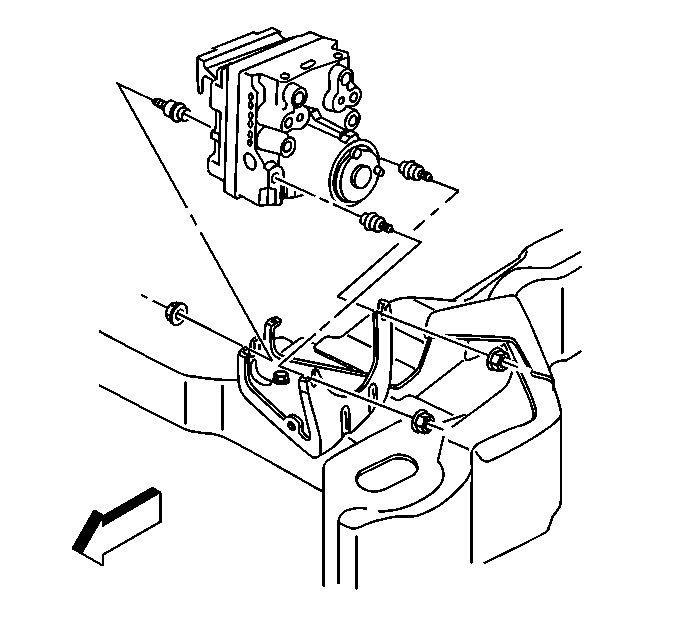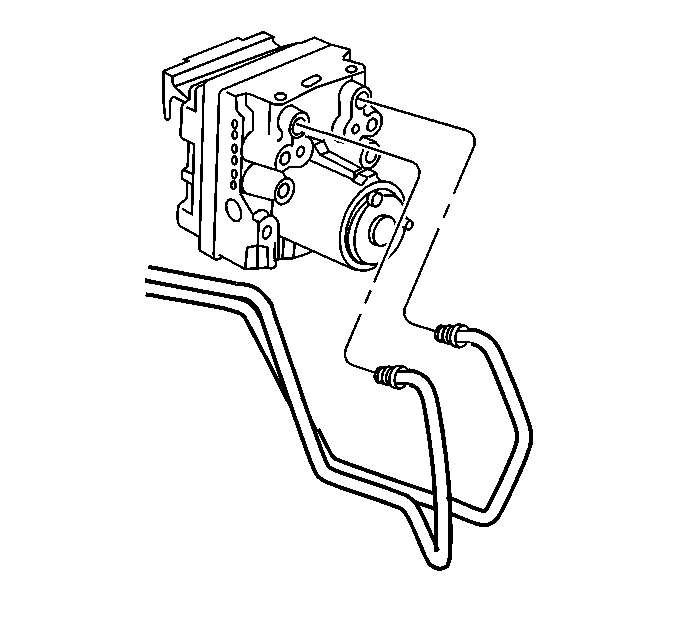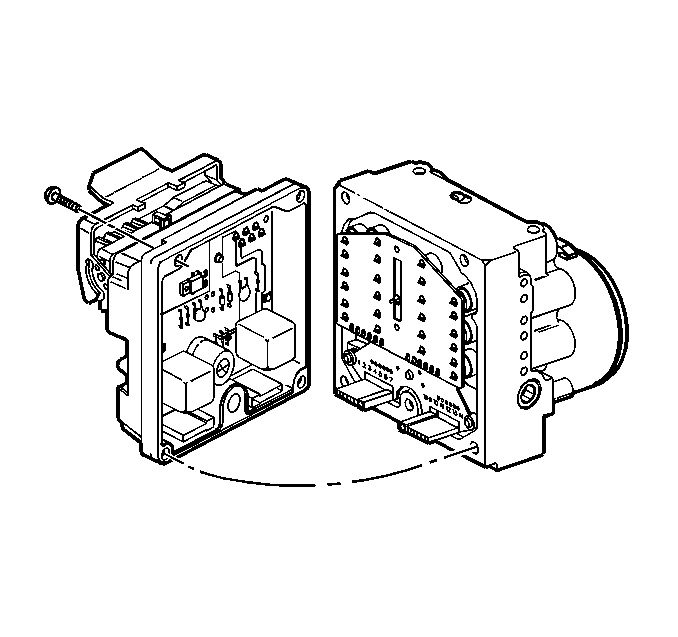Caution: Refer to Brake Fluid Irritant Caution in the Preface section.
Notice: Refer to Brake Fluid Effects on Paint and Electrical Components Notice in the Preface section.
Removal Procedure
- Turn OFF the ignition.
- Thoroughly wash all contaminants from around the EBCM/BPMV.
- Remove the 6 brake pipe fittings.
- Disconnect the EBCM connector and BPMV motor ground cable.
- Remove the 3 EBCM/BPMV assembly bracket nuts.
- Remove the EBCM/BPMV assembly from the vehicle.
- Remove the front insulator and insulator mounting bolt.
- Remove the four EBCM to BPMV bolts.
- Separate the EBCM from the BPMV by gently pulling forward until separated. Be careful not to damage the seal.
- Clean any brake fluid spillage from the BPMV.
- Clean the seal and BPMV gasket surface with denatured alcohol.

Caution: For safety reasons, the brake pressure modulator valve assembly must not be repaired, the complete unit must be replaced. With the exception of the EBCM, no screws on the brake pressure modulator valve assembly may be loosened. If screws are loosened, it will not be possible to get the brake circuits leak-tight and personal injury may result.
Important: The area around the Electronic Brake Control Module (EBCM) Brake Pressure Modulator Valve (BPMV) must be free from loose dirt to prevent contamination of disassembled ABS components.

Notice: When removing the brake pressure modulator valve, protect the vehicle exterior from possible brake fluid spillage. Brake fluid can cause damage to painted surfaces.
Notice: Excessive bending of brake pipes during BPMV removal or installation may cause permanent damage that will require replacement.
Important: Note the location of the brake pipes to use as an aid during installation.

Important: Do not pry the EBCM from the BPMV.
Installation Procedure
- Install the EBCM to the BPMV.
- Install the 4 EBCM to BPMV bolts.
- Install the front insulator and insulator mounting bolt.
- Position the EBCM/BPMV assembly in the bracket and install insulators and bracket nuts.
- Install the EBCM/BPMV assembly bracket nuts.
- Install the 6 brake pipe fittings, using locations noted during removal.
- Install the EBCM connector. Make sure the EBCM connector tab is locked down.
- Install the pump motor ground cable connector.
- Fill and bleed hydraulic brake system. Refer to Hydraulic Brake System Bleeding in Hydraulic Brakes.
- Perform the Auto Bleed Procedure. Refer to Antilock Brake System Automated Bleed Procedure .
- Perform the ABS Diagnostic System Check. Refer to Diagnostic System Check - ABS .

Notice: Use the correct fastener in the correct location. Replacement fasteners must be the correct part number for that application. Fasteners requiring replacement or fasteners requiring the use of thread locking compound or sealant are identified in the service procedure. Do not use paints, lubricants, or corrosion inhibitors on fasteners or fastener joint surfaces unless specified. These coatings affect fastener torque and joint clamping force and may damage the fastener. Use the correct tightening sequence and specifications when installing fasteners in order to avoid damage to parts and systems.
Tighten
Tighten the 4 bolts to 6 N·m (53 lb in).
Tighten
Tighten the insulator bolt to 14 N·m (10 lb ft).

Important: If a new BPMV is being installed, remove the shipping plugs from the valve openings.
Tighten
Tighten the bracket nuts to 10 N·m (89 lb in).
Caution: The brake pipes must be fully installed to the brake pipe mounting retainers on the frame. Failure to properly retain the brake pipes may cause the pipes to contact the frame and/or the transmission resulting in possible loss of brake fluid and personal injury.

Caution: Make sure brake pipes are correctly connected to BPMV. If brake pipes are switched by mistake Inlet vs. Outlet, wheel lockup will occur and personal injury may result.
Tighten
Tighten the 6 brake pipe fittings at the BPMV to 16 N·m
(12 lb ft).
